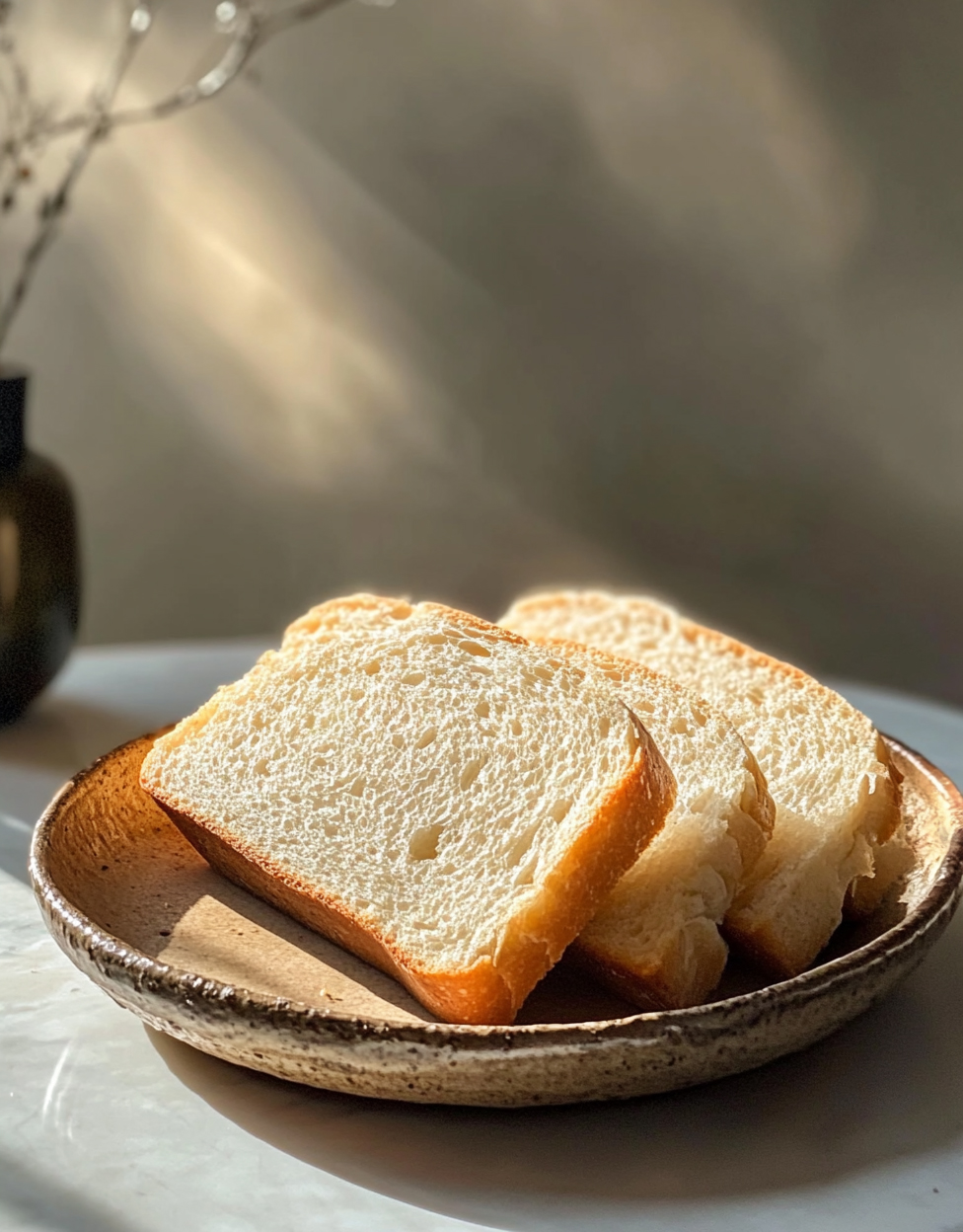
Sourdough Sandwich Bread: A Complete Guide
Introduction
In recent years, sourdough sandwich bread has surged in popularity, captivating the taste buds of bread lovers everywhere. This growing interest comes not only from its unique flavor but also from its digestibility and many health benefits.
Sourdough differs from conventional bread by using a natural fermentation process instead of commercial yeast for leavening. Wild yeast and lactic acid bacteria actively participate in this process, giving sourdough its unique characteristics.
. This process results in a loaf with a distinct tangy flavor and a chewy texture—qualities that make it particularly well-suited for sandwiches.
The fascination with sourdough is not a modern phenomenon. This bread has a rich history that spans millennia, making it as much a cultural icon as it is a culinary staple. But what exactly makes sourdough sandwich bread so special? Why is it that so many people are turning to this ancient method of bread-making, not just for its taste but also for its potential health benefits?
In this comprehensive guide, we’ll dive deep into what sets sourdough apart from other breads. We’ll explore the health advantages of incorporating sourdough into your diet and provide you with a detailed, step-by-step guide on how to make your very own sourdough sandwich bread at home.Additionally, we’ll share valuable tips to help you perfect your loaf, so you can build every sandwich on a foundation of delicious, healthy bread
What is Sourdough Sandwich Bread?
Sourdough sandwich bread is a type of bread that is naturally leavened. Unlike other breads that rely on commercial yeast to rise, sourdough uses a combination of wild yeast and lactic acid bacteria—naturally occurring organisms that live on flour and in the environment. This natural fermentation process is what gives sourdough its distinctive tangy flavor and slightly chewy texture. The fermentation process also contributes to sourdough’s longer shelf life, as the natural acids produced during fermentation help to preserve the bread.
A Brief History of Sourdough
As trade routes expanded and cultures interacted, the knowledge of sourdough spread across the ancient world. The Greeks and Romans adopted and refined sourdough techniques, making bread a staple in their diets. Roman soldiers, known for their extensive conquests, carried sourdough starters with them, spreading the practice throughout Europe.
During the Middle Ages, sourdough bread became a cornerstone of European diets, particularly in regions where the climate was favorable for the natural fermentation process. In colder areas where commercial yeast was less effective, sourdough remained the primary method for leavening bread. Bakers passed down their sourdough starters from generation to generation, often as family heirlooms, ensuring the continuation of this ancient tradition.
For those interested in learning more about the health benefits of fermented foods like sourdough, check out this guide on the benefits of fermented foods.
Health Benefits of Sourdough Sandwich Bread
While the taste of sourdough is a significant draw, the health benefits it offers are equally compelling. Sourdough bread is often considered a healthier alternative to conventional breads, and for good reason. The natural fermentation process not only enhances the flavor and texture of the bread but also improves its nutritional profile.
Nutritional Value
One of the primary health benefits of sourdough bread is its enhanced nutritional value. The fermentation process increases the bioavailability of nutrients, meaning your body can absorb and utilize them more effectively. During fermentation, the lactic acid bacteria in the dough help break down phytic acid—a compound found in grains that can inhibit the absorption of minerals such as iron, zinc, magnesium, and B vitamins. By reducing phytic acid levels, sourdough allows these essential nutrients to be more readily absorbed by the body.
In addition to minerals, sourdough is also a good source of vitamins, particularly the B vitamins. These vitamins are crucial for energy production, brain function, and the formation of red blood cells. Sourdough made with whole grain flours offers even more nutritional benefits, as it retains the bran and germ of the grain, which are rich in fiber, protein, and antioxidants.
Digestibility and Gluten Breakdown
Another significant advantage of sourdough is its digestibility. The natural fermentation process in sourdough breaks down gluten—a protein found in wheat that can be difficult for some people to digest. While sourdough is not gluten-free and should be avoided by those with celiac disease, it may be easier to digest for individuals with mild gluten sensitivities.
The extended fermentation time of sourdough allows for a more thorough breakdown of gluten, which can reduce bloating and discomfort in those who are sensitive to it. Furthermore, the fermentation process produces lactic acid, which lowers the pH of the bread and creates a more acidic environment that can further aid in digestion.
Lower Glycemic Index
Sourdough bread generally has a lower glycemic index (GI) compared to other types of bread. The glycemic index measures how quickly a food causes blood sugar levels to rise. Foods with a high GI cause rapid spikes in blood sugar, while those with a low GI lead to a slower, more gradual increase.
The natural acids produced during the fermentation of sourdough slow down the digestion of carbohydrates, resulting in a slower release of glucose into the bloodstream. This can be beneficial for managing blood sugar and insulin levels, making sourdough a good choice for people with diabetes or those looking to maintain steady energy levels throughout the day.
For a deeper understanding of the science behind sourdough fermentation and its health benefits, you can explore this article on the science of sourdough fermentation.
Ingredients for Making Sourdough Sandwich Bread
Making sourdough sandwich bread at home requires just a few simple ingredients. However, the quality of these ingredients is crucial to the final product. Each ingredient plays a specific role in the bread-making process, contributing to the flavor, texture, and overall success of your loaf.
Flour
The type of flour you use greatly affects the texture and flavor of your sourdough bread. The most common flours used for sourdough are:
- White Flour: Made from wheat, white flour is the most commonly used flour for sourdough bread. It produces a light, airy loaf with a mild flavor. White flour is often preferred for sandwich bread because it creates a soft crumb that is easy to slice and holds up well to fillings.
- Whole Wheat Flour: Whole wheat flour is made from the entire wheat kernel, including the bran and germ. This flour is richer in nutrients and fiber, giving the bread a denser texture and a more robust flavor. Whole wheat sourdough bread is heartier and more filling, making it a great choice for those who prefer a more substantial loaf.
- Rye Flour: Rye flour is often used in combination with other flours to give sourdough bread a distinctive earthy flavor and a denser crumb. Rye sourdough is particularly popular in European countries, where it is often paired with hearty fillings like cured meats and cheeses.
Choosing the right flour for your sourdough bread depends on your personal preferences and the type of loaf you want to create. For more information on selecting the best flour for baking, refer to this guide on different types of flour for baking.
Water
Water is a crucial ingredient in sourdough bread, as it hydrates the flour and activates the enzymes that break down the starches. The water you use can also impact the fermentation process. For the best results, it’s recommended to use filtered water to avoid any chlorine or other chemicals that might inhibit the activity of the yeast and bacteria in your sourdough starter.
The amount of water used in the dough, known as hydration, plays a significant role in the texture of the bread. A higher hydration dough will produce a more open crumb with larger air pockets, while a lower hydration dough will result in a denser, more compact crumb. For sourdough sandwich bread, a medium hydration dough (around 65-70%) is often preferred to create a soft, yet sturdy loaf.
Salt
Salt is a crucial ingredient in sourdough bread, added not only for flavor but also to regulate the fermentation process. It strengthens the gluten network in the dough, which helps the bread maintain its shape and rise evenly. It also slows down the activity of the yeast, allowing for a longer, more controlled fermentation period that enhances the flavor of the bread.
The type of salt you use can also affect the flavor of your bread. Fine sea salt or kosher salt is commonly used in baking, as it dissolves easily and evenly distributes throughout the dough. It’s important to measure salt accurately, as too much can inhibit the fermentation process, while too little can result in a bland-tasting loaf.
Sourdough Starter
The sourdough starter is the heart of your sourdough bread. This natural leavening agent is made from a mixture of flour and water that has been fermented by wild yeast and lactic acid bacteria. A healthy, active sourdough starter is full of bubbles, indicating that the yeast and bacteria are active and ready to leaven your dough.
Maintaining a sourdough starter requires regular feeding with fresh flour and water. The starter should be kept at room temperature if you plan to bake frequently, or it can be stored in the refrigerator if you only bake occasionally. Before using your starter in a recipe, it should be fed and allowed to become bubbly and active, which usually takes about 4-6 hours.
How to Make Sourdough Sandwich Bread
Creating sourdough sandwich bread at home is a rewarding experience that combines traditional baking techniques with natural fermentation. While it requires some time and patience, the end result is well worth the effort. Here’s a step-by-step guide to help you achieve a perfect loaf:
1. Preparing the Sourdough Starter
To make sourdough sandwich bread, you’ll need an active sourdough starter. If you don’t already have one, you can create your own from scratch. This process typically takes 5-7 days.
- Ingredients: 1 cup of flour, 1 cup of water.
- Process: Mix equal parts of flour and water in a jar. Cover it loosely and let it sit at room temperature. Each day, feed the starter by discarding half of the mixture and replenishing with fresh flour and water. Stir well and cover again. After about a week, your starter should be bubbly and active, ready to use in baking.
2. Mixing and Kneading the Dough
Once your sourdough starter is active, you can begin making the dough for your sandwich bread.
- Ingredients:
- 1 cup of active sourdough starter
- 3 ½ cups of flour
- 1 ¼ cups of water
- 1 ½ teaspoons of salt
- 2 tablespoons of sugar (optional, for sweetness)
- 2 tablespoons of butter or oil (for softness).
- Process:
- In a large mixing bowl, combine the sourdough starter, water, and flour until a shaggy dough forms.
- Let the dough rest for about 30 minutes (this step is known as autolyse). This allows the flour to fully hydrate and makes the dough easier to work with.
- After the autolyse, add the salt, sugar, and butter or oil to the dough. Mix well until the ingredients are fully incorporated.
- Knead the dough by hand for about 10-15 minutes, or until it becomes smooth and elastic. Alternatively, you can use a stand mixer with a dough hook attachment to knead the dough for 8-10 minutes.
3. Proofing and Shaping the Dough
After kneading, the dough needs to undergo a bulk fermentation process, where it will rise and develop flavor.
- First Rise: Place the kneaded dough in a lightly greased bowl, cover it with a damp cloth or plastic wrap, and let it rise at room temperature for 4-6 hours, or until it has doubled in size.
- Shaping the Dough: Once the dough has risen, gently turn it out onto a lightly floured surface. Shape the dough into a rectangle, then fold it into thirds like an envelope, tucking the sides in to form a loaf shape.
- Final Proof: Place the shaped dough into a greased loaf pan, seam side down. Cover and let it proof for 1-2 hours, or until it has risen slightly above the rim of the pan.
4. Baking the Bread
Baking is where your dough transforms into a delicious loaf of bread.
- Preheat the Oven: Preheat your oven to 375°F (190°C).
- Bake the Bread: Place the loaf pan in the oven and bake for 30-40 minutes, or until the crust is golden brown and the loaf sounds hollow when tapped on the bottom. The internal temperature should reach 190°F (88°C) when fully baked.
- Cooling the Bread: Remove the bread from the oven and let it cool in the pan for about 10 minutes. Then, transfer it to a wire rack to cool completely before slicing.
Tips for Perfecting Sourdough Sandwich Bread
Even with a solid recipe, there are always tips and tricks to ensure your sourdough sandwich bread turns out perfectly every time. Here are some expert tips to help you master the art of sourdough baking:
Avoid Overproofing
One of the most common mistakes in sourdough baking is overproofing. Overproofing occurs when the dough rises for too long, causing the gluten structure to weaken and the dough to collapse. To avoid this, keep an eye on the dough during the final proof and bake it when it’s about 1 inch above the rim of the loaf pan.
Enhance Flavor
Proper Storage
To maintain the freshness and texture of your sourdough sandwich bread, proper storage is essential. Store the bread in a paper bag or wrap it in a clean kitchen towel to allow the crust to breathe. For longer storage, slice the bread and freeze it in an airtight container or freezer bag. Simply toast or thaw slices as needed.
FAQs About Sourdough Sandwich Bread
Is sourdough bread good for sandwiches?
Yes, sourdough bread is excellent for sandwiches. Its firm yet soft texture holds up well to a variety of fillings without becoming soggy. The slight tanginess of the bread also complements many sandwich ingredients, making it a versatile and delicious choice.
Is sourdough bread healthier bread?
Sourdough bread is considered healthier than many other types of bread due to its natural fermentation process. The fermentation helps break down gluten, making it easier to digest, and increases the availability of nutrients like iron, zinc, and magnesium. Additionally, sourdough typically has a lower glycemic index, which means it causes a slower rise in blood sugar levels.
What temperature is a sourdough sandwich bread done?
Sourdough sandwich bread is done when its internal temperature reaches around 190°F to 200°F (88°C to 93°C). To check, use an instant-read thermometer inserted into the center of the loaf. The bread should also sound hollow when tapped on the bottom.
How to get softer sourdough bread?
To achieve softer sourdough bread:
- Add Fat: Incorporate a small amount of fat, like butter or oil, into the dough to soften the crumb.
- Increase Hydration: Slightly increase the water content in the dough for a softer texture.
- Use a Lower Baking Temperature: Bake at a slightly lower temperature (around 375°F or 190°C) to avoid a thick crust.
- Cover During Baking: Cover the bread with foil or a lid for the first part of the bake to trap steam, which helps keep the crust soft.
Why is my sourdough sandwich bread dense?
Dense sourdough bread can result from several factors:
- Underproofing: The dough did not rise enough before baking.
- Low Hydration: The dough may have too little water, leading to a denser crumb.
- Insufficient Kneading: The gluten may not have developed properly, preventing the bread from rising well.
Why is my sourdough bread so hard?
Hard sourdough bread is often caused by:
- Overbaking: Baking the bread for too long or at too high a temperature can create a tough crust.
- Low Hydration: If the dough lacks sufficient water, it can lead to a hard loaf.
- Inadequate Proofing: Overproofed or underproofed dough can result in a hard texture.
How to prevent sourdough bread from getting hard?
To prevent sourdough bread from getting hard:
- Proper Storage: Store the bread in a paper bag or wrap it in a clean kitchen towel to maintain the crust’s texture.
- Avoid Overbaking: Monitor the baking time and temperature to prevent the bread from becoming too hard.
- Increase Hydration: Ensure the dough has enough water to create a softer crumb.
How to make sourdough bread soft again?
If your sourdough bread has become hard, you can soften it by:
- Reheating: Wrap the bread in a damp towel and place it in the oven at 300°F (150°C) for 5-10 minutes.
- Microwaving: Place the bread in the microwave with a cup of water for about 20 seconds to add moisture back into the loaf.
- Steam It: Reheat the bread in a steamy environment, like over a pot of boiling water, to soften the crust.
What makes sourdough bread tough and chewy?
Tough and chewy sourdough bread can result from:
- Overkneading: Excessive kneading can lead to overdeveloped gluten, making the bread tough.
- Overbaking: Baking the bread for too long can dry it out, resulting in a tough and chewy texture.
- Low Hydration: A dough with too little water can produce a dense, chewy crumb.
How do you increase the texture of sourdough bread?
To improve the texture of sourdough bread:
- Proper Hydration: Adjust the water content to achieve the desired crumb structure.
- Stretch and Fold: Use the stretch and fold method during bulk fermentation to build strength in the dough.
- Correct Proofing: Ensure the dough is proofed correctly to avoid dense or overly airy textures.
Why is my sourdough not crunchy?
If your sourdough bread is not crunchy:
- Increase Baking Temperature: Bake at a higher temperature (around 450°F or 230°C) to create a crustier exterior.
- Steam During Baking: Add steam to the oven during the first 10-15 minutes of baking to help form a crisp crust.
- Avoid Softening Agents: Do not add too much fat or sugar, as these can soften the crust.
These answers should help you troubleshoot and improve your sourdough sandwich bread, ensuring it turns out perfectly every time.
Conclusion
Sourdough sandwich bread is more than just a tasty option for your meals; it’s a healthy and satisfying choice you can easily make at home. With the right ingredients and a bit of patience, you can create a loaf perfect for sandwiches, toast, and more. Whether you’re an experienced baker or just starting out, this guide will help you craft the perfect sourdough sandwich bread.
Making sourdough may seem daunting at first, but with practice, it becomes second nature. The reward is a loaf that tastes incredible and supports your health in ways commercial bread can’t. So why not give it a try? Start your sourdough journey today and enjoy the natural, nutritious, and flavorful bread you create.
The process of making sourdough may seem daunting at first, but with practice, you’ll find that it becomes second nature. The reward is a loaf of bread that not only tastes incredible but also supports your health in ways that commercial bread simply can’t match. So why not give it a try? Begin your sourdough journey today and experience the joy of baking and eating bread in its natural, nutritious, and flavorful form.

Posted by: Hailee | December 20, 2024
I’m passionate about sharing sweet and savory recipes that I’ve meticulously tested and perfected in my own kitchen. Join me on this delicious journey to experience the best of culinary creativity.




